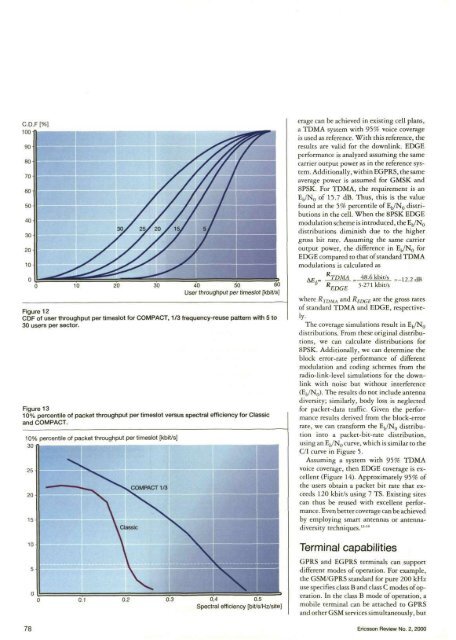erage can be achieved in existing cell plans,a TDMA system with 95% voice coverageis used as reference. With this reference, theresults are valid fot the downlink. EDGEperformance is analyzed assuming the samecattier output power as in the reference system.Additionally, within EGPRS, the sameaverage power is assumed for GMSK and8PSK. For TDMA, the requirement is anE b /N 0 of 15.7 dB. Thus, this is the valuefound at the 5% percentile of E b /N 0 distributionsin the cell. When the 8PSK EDGEmodulation scheme is introduced, the E b /N 0distributions diminish due to the highergross bit rate. Assuming the same carrieroutput power, the difference in E b /N 0 forEDGE <strong>com</strong>pared to that of standard TDMAmodulations is calculated asFigure 12CDF of user throughput per timeslot for COMPACT, 1/3 frequency-reuse pattern with 5 to30 users per sector.Figure 1310% percentile of packet throughput per timeslot versus spectral efficiency for Classicand COMPACT.where RTDMA an^ REDGE are tne gross ratesof standard TDMA and EDGE, respective-ly-The coverage simulations result in E b /N 0distributions. From these original distributions,we can calculate distributions for8PSK. Additionally, we can determine theblock error-rate performance of differentmodulation and coding schemes from theradio-link-level simulations for the downlinkwith noise but without interference(E b /N 0 ). The results do not include antennadiversity; similarly, body loss is neglectedfor packet-data traffic. Given the performanceresults derived from the block-errorrate, we can transform the E b /N 0 distributioninto a packet-bit-rate distribution,using an E b /N 0 curve, which is similar to theC/I curve in Figure 5.Assuming a system with 95% TDMAvoice coverage, then EDGE coverage is excellent(Figure 14). Approximately 95% ofthe users obtain a packet bit rate that exceeds120 kbit/s using 7 TS. Existing sitescan thus be reused with excellent performance.Even better coverage can be achievedby employing smart antennas or antennadiversitytechniques.""" 1Terminal capabilitiesGPRS and EGPRS terminals can supportdifferent modes of operation. For example,the GSM/GPRS standard for pure 200 kHzuse specifies class B and class C modes of operation.In the class B mode of operation, amobile terminal can be attached to GPRSand other GSM services simultaneously, but78 Ericsson Review No. 2,2000
can only operate one set of services at a time.In the class C mode of operation, the mobileterminal can attach to either GPRS or otherGSM services but not both. According tothese definitions, mobile terminals will bemade available for class B136 and CI36modes of operation, with a 200 kHz GPRSbasedpacket-data mode and a TIA/EIA-13630 kHz-based circuit-switched mode. TheCOMPACT and Classic systems ac<strong>com</strong>modatethe class B136, CI36, and pure200 kHz class C (GPRS) modes of operation.ConclusionThe TDMA and GSM systems have chosenthe same EDGE radio-access and GPRSpacket-switched core network technologiesto provide third-generation services in existingspectrum. Accordingly, a <strong>com</strong>monaccess for data services can be offered to morethan 370 million mobile subscribers.EDGE can be deployed in two modes inTDMA systems: Classic and COMPACT.The Classic system requires only minimumextension to GSM EDGE and uses standardGSM/GPRS control channels, which facilitatesglobal roaming.The COMPACT system introduces anovel control channel configuration, synchronizedbase stations, and discontinuoustransmission on the first carriers, which facilitatesthe deployment of EDGE controlchannels in a 1/3 frequency-reuse pattern.Thus, the initial deployment of COMPACTrequires only a very limited amount of spec-Figure 14Throughput CDF in a coverage-limited system.trum—600 kHz plus guard bands. Withfractional loading, excellent spectral efficiencycan be attained with data rates of upto 384 kbit/s. COMPACT thus supportsUWCC requirements for third-generationservices with high spectral efficiency andinitial deployment within less than 1 MHzof spectrum.REFERENCES1 Re<strong>com</strong>mendation ITU-R M.1225, "Guidelinesfor Evaluation of Radio TransmissionTechnologies for IMT-2000."2 Furuskar, A., Frodigh, M., Olofsson, H. andSkold, J.: "System Performance of EDGE, aProposal for Enhanced Data Rates in ExistingDigital Cellular Systems," in proceedingsof IEEE VTC'98.3 Zangi, K., Furuskar, A. and Hook, M.: "EDGE:Enhanced Data Rates for Global Evolution ofGSM and IS-136," in proceedings of MultiDimensional Mobile Communications 1998(MDMC'98).4 Furuskar, A., Hook, M., Johansson, C. Javerbring,S. and Zangi, K.: "EDGE-EnhancedData Rates for Global Evolution," in proceedingsof Nordic Radio Symposium 1998(NRS'98).5 Furuskar, A., Mazur, S., Muller, F. and Olofsson,H.: "EDGE, Enhanced Data Rates forGSM and TDMA/136 Evolution," IEEE PersonalCommunications, June 1999.6 Furuskar, A., Naslund.J. and Olofsson, H.:EDGE, Enhanced Data Rates for GSM andTDMA/136 Evolution. Ericsson Review Vol.76(1999):1, pp. 28-37.7 ETSI. Tdoc SMG2 95/97. "EDGE FeasibilityStudy, Work Item 184; Improved Data Ratesthrough Optimised Modulation," version 0.3,December 1997.8 The UWC-136 RTT Candidate Submission.9 ETSI. TS 03.64V8.3.0 (2000-02), "Digital CellularTele<strong>com</strong>munications system (Phase 2+);General Packet Radio Service (GPRS); OverallDescription of the GPRS Radio Interface;Stage 2 (GSM 03.64 ver-sion 8.3.0)."10 ETSI. TS 09.18 V8.0.0 (1999-07), "Digital CellularTele<strong>com</strong>munications system (Phase 2+);General Packet Radio Service (GPRS); ServingGPRS Support Node (SGSN) - VisitorsLocation Register (VLR); Gs interface layer 3specification (GSM 09.18 version 8.0.0)."11 ETSI. TS 05.02 V8.3.0 (2000-01), "Digital CellularTele<strong>com</strong>munications system (Phase 2+);Multiplexing and multiple access on the radiopath (GSM 05.02 version 8.3.0)."12Blomquist, K., Kjellberg, J.-A.: "A Study ofSelf-Similar Data Traffic and Development ofa WWW Traffic Model", MSc Thesis,Linkbping University, Sweden, June 1997.13Derneryd, A and Johannisson B.: Adaptivebase-station antenna arrays. EricssonReview Vol. 76(1999):3, pp. 132-137.14Andersson, S., Carlqvist, B., Hagerman, B.and Lagerholrn, R.: Enhancing cellular networkcapacity with adaptive antennas. EricssonReview Vol. 76(1999):3, pp. 138-141.Ericsson Review No. 2, 2000 79















